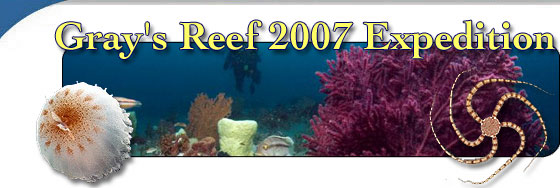Mission Log: June 13, 2007
Scott Noakes, Ph.D.
Research Scientist, The University of Georgia, Center for Applied Isotope Studies
 | | Noakes |
Many people may be wondering who gets selected to come out to Gray’s Reef on the R/V Nancy Foster and how their efforts are directed. I have been involved with paleontological and surficial geologic studies at Gray’s Reef and surrounding areas for several years. My home department at UGA does marine environmental surveys and also houses an accelerator mass spectrometer used in carbon dating organic-based samples (www.uga.edu/cais). With the AMS, scallop shells collected at Gray’s Reef and J reef have been dated to the 32,000-38,000 age before present. The whale bone which we relocated yesterday and evaluated for excavation was dated to ~35,000 years before present.
In addition to my work at CAIS-UGA, I am also the Director and Diving Safety Officer of the University System of Georgia Scientific Diving Program (www.uga.edu/diving), an AAUS organizational member. Many of the divers onboard the R/V Nancy Foster today are members of the dive program. NOAA has a reciprocal agreement with AAUS thus allowing our divers to dive off NOAA vessels as part of their research. That should be enough about all the technicalities that got us out here. The following text gives an overview of our activities from today.
 |
|
Thirty thousand year old scallop from when what is now Gray's Reef was a shallow embayment. (Photo: Gray's Reef National Marine Sanctuary)
|
Today’s weather with heavily overcast skies, 3-4 ft seas, and ~20 knot winds, was not the most favorable for working off small vessels, but doable. The NF4 was the first dive tender to be launched from the RV Nancy Foster with Georgia Southern divers Gleason, Hampton, Ruzicka, and Shopmeyer aboard. Immediately following the NF4 was NF2 with divers Grenda (REEF) and Noakes. Both vessels headed for nearby GR 20, a dive site within the Gray’s Reef boundaries and known for its ledges, live bottom and fossilized scallop bed. The RV Nancy Foster was standing by at all times and could view both dive vessels.
 |
|
Paul Gayes and Jamie Phillips with CHIRP over the side and ready to collect data. (Photo: Gray's Reef National Marine Sanctuary)
|
The divers completed two dives at site “GR-20” this morning between 9 and 11 a.m. and reported a rather dismal 10 ft visibility on the bottom, but better than yesterday’s 5 ft. All divers were using NITROX which allowed for extended bottom times and a short surface interval before returning for the second dive.
The Georgia Southern team continued their work on developing a new check sheet printed on waterproof paper that the divers can utilize in identifying live bottom organisms such as tunicates and sponges. By equipping their divers with this check sheet, they hope to standardize their identifying process for the Gray’s Reef and surrounding areas. Dave Grenda continued his fish count work for REEF (see yesterday’s log) identifying specimens while slowly traveling along the rock outcrop. I relocated the fossilized scallop bed in several locations and continued scanning for any fossilized bone fragments.
 |
|
Paul Gayes and Jamie Phillips ready to deploy CHIRP at sunset. (Photo: Gray's Reef National Marine Sanctuary)
|
Among the sightings at GR 20, divers reported seeing a large ray with a wingspan of approximately 4 feet with an entourage of cobia in tow. A large loggerhead turtle was also spotted resting underneath one of the ledges. I guess when you get to be as large as she was; a couple of divers aren’t enough to give up a good nap. A 7 ft nurse shark was also spotted nearby resting partially under one of the ledges. Nurse sharks being such shy creatures, she quickly departed when we drifted by. Unfortunately for me, no unusual fossilized specimens were discovered, but overall, this morning’s dives were well worth the effort.
Unfortunately, the ship’s Nitrox dive compressor broke down while filling tanks last night so we won’t have tanks for the planned afternoon dives. The ship’s crew has been working on the compressor, but so far no luck with the repairs. Later tonight, the Coastal Carolina team will deploy their CHIRP to continue their sub bottom profiling work on the geologic structure in the Gray’s Reef area.
|



